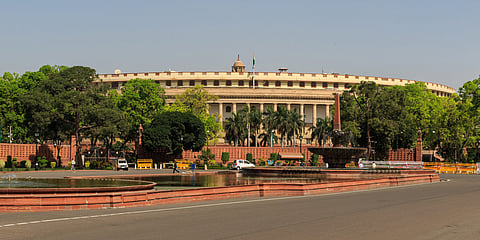

[dropcap]T[/dropcap]HE process of electing the 17th Lok Sabha will be completed on May 18, 2019, and the answer to the question on everyone's mind – who will form the next government – will most probably be revealed by the evening of May 23.
Keen observers of the political scene believe that the chances of any party or combination getting a majority are weak. So there is every likelihood that there will be a hung Parliament. There is nothing unusual or shocking about such a result; there have been similar situations in the past.
But a host of questions of constitutional importance are bound to arise if no party gets a majority. Who will the President call to form the government? Is it the single largest party or a pre-poll alliance? Or should he call a post-poll alliance if they have a majority? All of these questions are important and luckily for us, there are precedents for these situations.
What then is the constitutionally correct procedure? After all the President is the protector of the Constitution and therefore, whatever decision he takes should be constitutionally correct.
Article 75 says that the council of ministers shall be collectively responsible to the House of the People. It means that the council of ministers must command a majority in the House. The earlier part of the above Article says that the Prime Minister shall be appointed by the President and other ministers shall be appointed by the President on the advice of the Prime Minister.
Normally the leader of the party which gets the majority in the elections is invited to form the government. By convention the leader of a pre-poll coalition, if it gets a majority, is also invited to form the Government. But the problem arises when no pre-poll alliance secures an absolute majority. In such a situation, can the President invite the single largest party or the largest coalition which has a larger number of MPs than each of the other coalitions?
Article 75 requires the President to appoint a council of ministers which enjoys the majority support in the House of the People. It would simply mean that the President is required to satisfy himself that the council of ministers, he appoints enjoys the support of the majority of the members of the House of the People. He has to do this before he appoints the Council of Ministers.
In other words, the President does not have the option or liberty to appoint a Council of Ministers which does not have the support of the majority of the members in the House of the People. Article 75 implies that the President cannot just appoint anyone as Prime Minister and leave him to prove his majority in the House. This was, of course, done in the past, but such a step goes against the spirit of Article 75 and weakens the authority of the President. He alone has the authority to appoint the Council of Ministers and the Constitution asks him to appoint a Council of Ministers which has the majority support in the House.
So, the President is duty bound to ascertain the number of members who support a particular person who has staked his claim to form the Government before he appoints him as the Prime Minister.
In this context, an interesting trend must be pointed out. After a Council of Ministers, which does not have a clear majority, is appointed, the Prime Minister is asked to prove his majority in the House through a Confidence Motion, even though, there is no provision in the House Rules for such a motion. There is provision only for a No-Confidence Motion and a No-Confidence Motion is moved by someone from the Opposition.
The Rules of Procedure presumes that the Council of Ministers enjoys confidence until it is voted out through a No-Confidence Motion. This presumption arises out of the mandate of Article 75 that the Council of Ministers appointed by the President shall enjoy the majority support in the House.
Article 75 read with Rule 198 of the Rules of Procedure of the Lok Sabha makes it clear that a Council of Ministers appointed by the President is presumed to enjoy the majority till it is voted out through a No-Confidence Motion. The President is the Head of the State and is entrusted with the solemn duty to appoint the Council of Ministers which enjoys the majority support in the House of the People. After such appointment, there is no need for the Council to prove its majority till a No- Confidence Motion is moved. The appointment of the Council of Ministers by the President cannot be treated as a tentative step. That is against the scheme of Article 75 of the Constitution.
The late President K R Narayanan, while appointing Shri Atal Bihar Vajpayee as the Prime Minister followed this procedure. He satisfied himself about the majority support before appointing Shri Vajpayee as Prime Minister. This is the correct Constitutional procedure which every President who takes an oath to protect and preserve the Constitution is required to follow. Any other procedure has no sanction under the Constitution.
[P D T Achary is a former Secretary General of the Lok Sabha.]